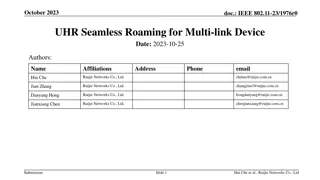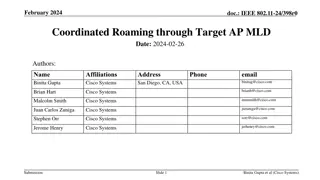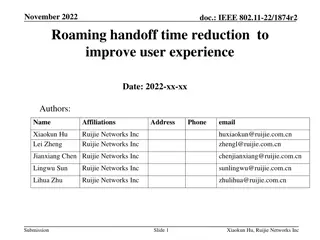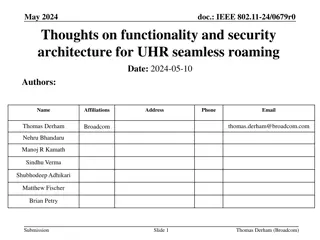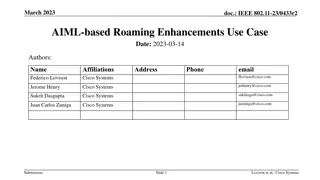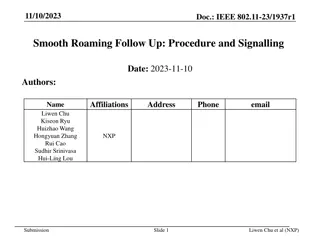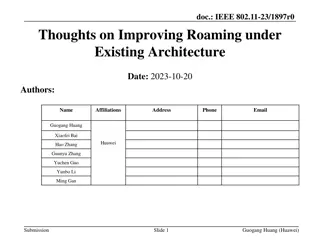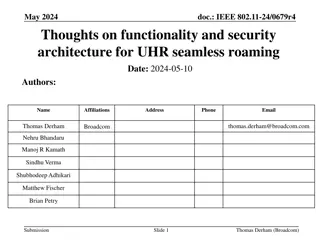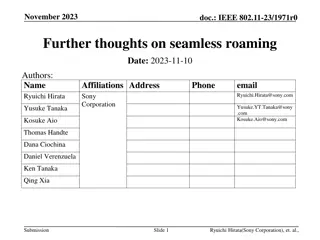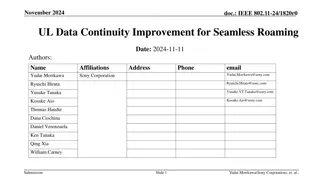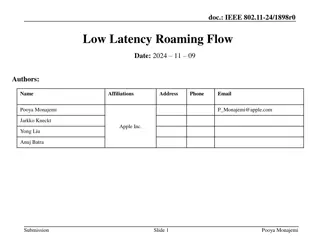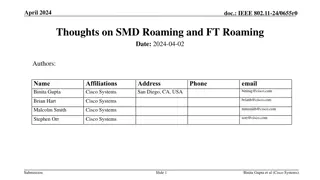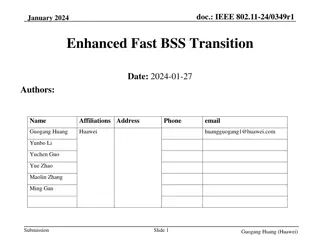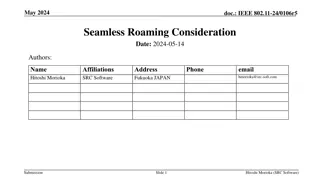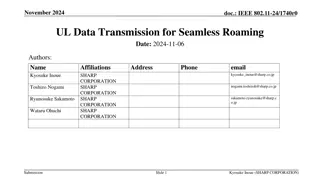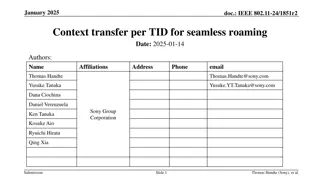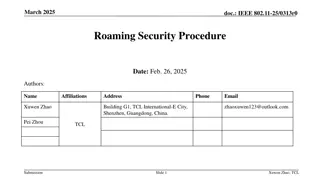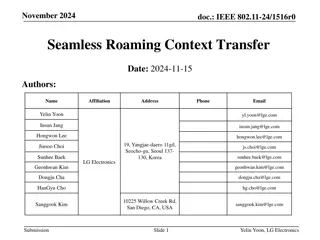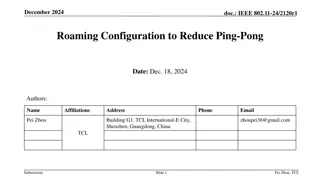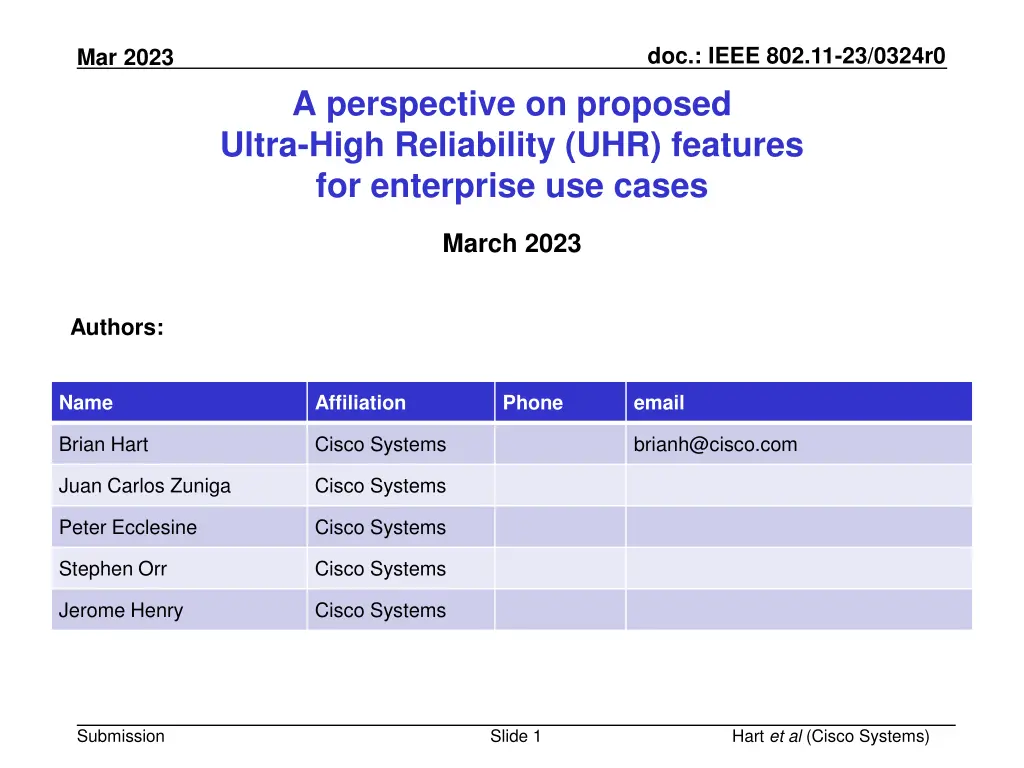
High Reliability Features for Enterprise Use Cases
Explore the perspective on proposed Ultra-High Reliability (UHR) features for enterprise use cases in the IEEE 802.11-23/0324r0 document. The content delves into the implications of roaming, duplicates, and out-of-order delivery within a flow, offering insights into roaming rates and their impact on reliability for various scenarios. Authors from Cisco Systems present a detailed analysis of perfect roaming versus roaming with hysteresis, shedding light on key considerations for enhancing reliability in networking environments.
Download Presentation

Please find below an Image/Link to download the presentation.
The content on the website is provided AS IS for your information and personal use only. It may not be sold, licensed, or shared on other websites without obtaining consent from the author. If you encounter any issues during the download, it is possible that the publisher has removed the file from their server.
You are allowed to download the files provided on this website for personal or commercial use, subject to the condition that they are used lawfully. All files are the property of their respective owners.
The content on the website is provided AS IS for your information and personal use only. It may not be sold, licensed, or shared on other websites without obtaining consent from the author.
E N D
Presentation Transcript
doc.: IEEE 802.11-23/0324r0 Mar 2023 A perspective on proposed Ultra-High Reliability (UHR) features for enterprise use cases March 2023 Authors: Name Affiliation Phone email Brian Hart Cisco Systems brianh@cisco.com Juan Carlos Zuniga Cisco Systems Peter Ecclesine Cisco Systems Stephen Orr Cisco Systems Jerome Henry Cisco Systems Submission Slide 1 Hart et al (Cisco Systems)
doc.: IEEE 802.11-23/0324r0 Mar 2023 Upper Layers Impose Rigid Requirements on Duplicates and Out-of-Order Delivery within a flow Constrains solutions to roaming & Joint RX A non-AP MLD is basically not allowed to be served by multiple DSAPs* Exceptions include splitting by UP or by flow hash Shortest Path Bridging (SPB) is defined in 802.1Q-2018 and enables multipath routing Yet, re frame duplication, between SAPs, this is still one-path-at-a- time-per-flow routing since: Network When Bridges in a network connect individual LANs in such a way that physical topology is capable of providing multiple paths between any source and destination, a protocol is required to ensure that the active topology comprises a single path. X Multiple Distribution Service Access Points serving the non-AP MLD Re frame misordering, we need to worry about it and be able to disable any feature that causes frame misordering: Some known LAN protocols, for example, LLC Type 2 (ISO/IEC 8802-2), are sensitive to frame misordering and duplication; in order to allow Bridges that support RSTP to be used in environments where sensitive protocols are in use, the forceVersion parameter (13.7.2) can be used to force a Bridge that supports RSTP to operate in an STP-compatible manner. Other protocols: AP MLD1 AP MLD2 Multipath TCP (RFC 8684) but TCP only MP-QUIC (draft-lmbdhk-quic-multipath-00) is for UDP but is not wide-spread Non-AP MLD Submission Slide 2 Hart et al (Cisco Systems) Hart et al (Cisco Systems)
doc.: IEEE 802.11-23/0324r0 Mar 2023 Roaming Rate Impacts Reliability Perfect Roaming For instance, Augmented Reality while on the move BSA 100 m2 250 m2 500 m2 Speed Study roaming model: AP BSA is 100-250-500m2 on a noisy grid Non-AP MLD travels at 1-1.5-2 meters/sec along lines at a random orientation wrt APs Perfect proximity-based roaming (no hysteresis) Non-AP MLD roaming events mostly occur every 0.6-31.6 sec, where a roam every 9.3 sec is reasonably typical (Table 1) 1 m/s 1.2 8.8 14.1 1.8 13.9 22.3 2.6 19.7 31.6 1.5 m/s 0.8 5.9 9.4 1.2 9.3 14.9 1.7 13.1 21.0 2 m/s 0.6 4.4 7.0 0.9 6.9 11.2 1.3 9.8 15.8 Table 1: Roam interval (sec) [P5 P50 P95], P/ercentile Roam interval 0.6 s 4 s 8 s 16 s 32 s Disruption duration 4 msec 99.3 99.9 99.95 99.98 99.99 Study impact of roaming model on reliability of QoS flow: Assume 4-8-16 msec of data is lost during each roam (not delivered or delivered too late). Reliability of a QoS flow assuming roaming is the only impairment is 97.3-99.99% (Table 2) 8 msec 98.7 99.8 99.9 99.95 99.98 16 msec 97.3 99.6 99.8 99.9 99.95 Table 2: Reliability (%) Submission Slide 3 Hart et al (Cisco Systems) Hart et al (Cisco Systems)
doc.: IEEE 802.11-23/0324r0 Mar 2023 Roaming Rate Impacts Reliability Roaming with Hysteresis BSA 100 m2 250 m2 500 m2 Speed Study roaming model: AP BSA is 100-250-500m2 on a noisy grid Non-AP MLD travels at 1-1.5-2 meters/sec along lines at a random orientation wrt APs Roam whenever sqrt(2) closer to another AP (i.e., whenever another AP is 3-5dB better) Non-AP MLD roaming events mostly every 1.7- 37.2 sec, where once every 10.5 sec is reasonably typical (Table 1) 1 m/s 3.5 9.9 16.6 5.6 15.7 26.3 7.9 15.7 37.2 1.5 m/s 2.3 .6 11.1 3.7 10.5 17.6 5.3 14.8 24.8 2 m/s 1.7 4.9 8.3 2.8 7.8 13.2 3.9 11.1 18.6 Table 1: Roam interval (sec) [P5 P50 P95], P/ercentile Roam interval 1.5 s 4 s 10 s 20 s 40 s Disruption duration 4 msec 99.7 99.9 99.96 99.98 99.99 8 msec 99.5 99.8 99.92 99.96 99.98 Study impact of roaming model on reliability of QoS flow: Assume 4-8-16 msec of data is lost during each roam (not delivered or delivered too late). Reliability of a QoS flow, assuming roaming is the only impairment, is 99.3-99.99% (Table 2) 16 msec 99.3 99.6 99.8 99.9 99.96 Table 2: Reliability (%) Submission Slide 4 Hart et al (Cisco Systems) Hart et al (Cisco Systems)
doc.: IEEE 802.11-23/0324r0 Mar 2023 What Level of Roaming Performance is Really Required? At the infrastructure, roaming involves a transfer of state from one AP MLD to another The required level of roaming performance determines how much state, and what state i.e., infrastructure roaming complexity We solicit what is sufficient roaming performance for current and anticipated use cases Submission Slide 5 Hart et al (Cisco Systems) Hart et al (Cisco Systems)
doc.: IEEE 802.11-23/0324r0 Mar 2023 Straw-poll: Which roaming goal do you prefer? Option A: no lost MSDUs and temporary latency increase of W msec during roaming For example, W = 8 msec // Much higher infrastructure complexity: please advise why Option B: potential for losing X msec of MSDUs during roaming, but minimal increase in latency for MSDUs transferred during roaming For example, X = 8 msec Option C: define an SLA# and a roaming model and lump all impairments, including from roaming, together and compare that against the SLA For example, 99.9% of MSDUs delivered within 8 msec. Abstain Slide 6 #Y% of MSDUs delivered within Z msec Submission Hart et al (Cisco Systems) Hart et al (Cisco Systems)

